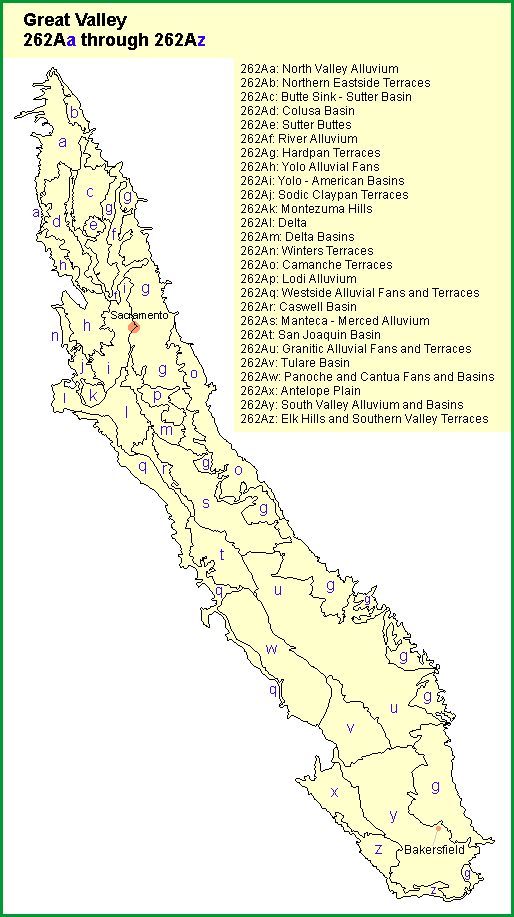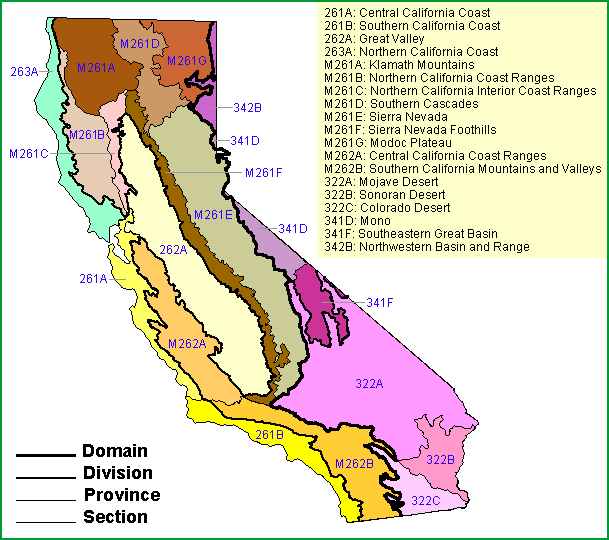 | Great Valley |
|
|
http://www.fs.fed.us/r5/projects/ecoregions/262a.htm
This section contains the alluvial plains of the Sacramento and San Joaquin Valleys. Summers are hot and dry and winters are mild. Oceanic influence on climate is slight in the middle of the Great Valley, which receives some marine air through the Carquinez Straits, but becomes negligible at the north and south ends of the Valley. MLRAs 15 and 17.
Geomorphology. Low fluviatile plain. Great Valley geomorphic province.
Lithology. Cenozoic nonmarine sedimentary rocks and alluvial deposits.
Soil Taxa. Alfisols, Aridisols, Entisols, Histisols, Inceptisols, Mollisols and Vertisols in combination with a thermic soil temperature regime and xeric, aquic or aridic soil moisture regimes.
Vegetation. Predominant potential natural communities include Purple needlegrass series, Valley oak series, vernal pools and wetland communities, blue oak series, allscale series and saltgrass series.
The following series are found throughout the section and are not restricted to or extensive in any subsection. Series dominated by exotic plants are not listed under subsections unless they are extensive and stable.
Series dominated by exotic plants: California annual grassland series, Cheatgrass series, Common reed series, Eucalyptus series, Introduced perennial grassland series, Kentucky bluegrass series and Tamarisk series.
Series that can occur in all subsections, but are not extensive: Bulrush series, Bulrush - cattail series, Cattail series, Duckweed series, Mexican elderberry series, Mosquito fern series, One-sided bluegrass series, Pondweeds with floating leaves series, Pondweeds with submerged leaves series, Saltgrass series, Sedge series and Spikerush series.
Series restricted to riparian settings: Arroyo willow series, Black willow series, Buttonbush series, California sycamore series, Fremont cottonwood series, Mixed willow series, Mulefat series, Narrowleaf willow series, Pacific willow series, Red willow series and White alder series.
Fauna. Former inhabitants include grizzly bear, wolf, tule elk, and pronghorn antelope. Much of the natural habitat has been modified throughout the section. The section contains wetlands that are important feeding and resting areas for migrating waterfowl. Many waterfowl species are year around residents. Mammals include mule deer, black-tailed deer, coyotes, muskrats, beavers, ground squirrels, cottontails, jack rabbits, kangaroo rats and the endangered kit fox. Common birds include hawks, golden eagle, owls, white-tailed kite, quail, mourning dove, mockingbird, scrub jay, gulls, herons, crows, western meadow lark, finches, sparrows, roadrunners (southern part) and the introduced Chinese ringneck pheasant. Tule elk herds have been reestablished in some southern parts of the section.
Elevation. Sea Level to 2000 feet.
Precipitation. 5 to 25 inches.
Temperature. 56░ to 62░F.
Growing Season. 250 to 300 days.
Surface Water Characteristics. Many slow moving rivers flow to the delta east of San Francisco Bay via the Sacramento and San Joaquin River systems. Flows to these levied, alluvial channel river systems is regulated throughout the year by the many dams occurring in adjacent sections. Constructed deep water ship channels also connect San Francisco Bay to Sacramento and Stockton. Many rivers and perennial streams flow west from the Sierra Nevada foothill section to the Sacramento and San Joaquin Rivers. The many alluvial channels that flow eastward from the Coast Ranges to the Sacramento and San Joaquin Rivers are mostly dry during summer months, only a few are perennial streams. The southern part of the San Joaquin Valley drains to basins and does not reach the San Joaquin River.
Disturbance Regimes.
Fire: Historic occurrence has changed from frequent, fast moving large fires to infrequent small fires, or fire has been mostly excluded because of conversion to irrigated agriculture and urban uses.
Flooding: Although mostly controlled by levee systems, seasonal flooding was extensive in this section.
Land Use. Composition and successional sequence of some communities (especially grassland communities) has changed because of plant and animal species introduced between the early 1800Æs and early 1900Æs related to grazing, agriculture, and urbanization. Most of the section is converted to irrigated agriculture. Rapidly expanding urbanized areas are scattered throughout the section. Flood control has decreased the duration and extent of wetlands.
Cultural Ecology. Humans have been utilizing the central valley for 10,000 years, and have been an integral part of its ecology for 3,000 to 5,000 years. The valley contains some of the densest year-round prehistoric habitation locations in California, particularly along riparian areas, where intensive occupation, resource procurement and processing practices, and vegetation manipulation through the use of fire sometimes altered the environment. Around the time of the Gold Rush, Euroamericans flooded into the valley, converting the land to agriculture, which became the mainstay of California economy. The river systems provided early transportation routes. Sacramento and Stockton are shipping ports served by deep water channels. Contemporary attitudes and beliefs are varied; lifestyles are both urban and rural; economies are dominated by agriculture, government, and services; populations are diverse.
Subsections. The Great Valley section is divided into 26 subsections

